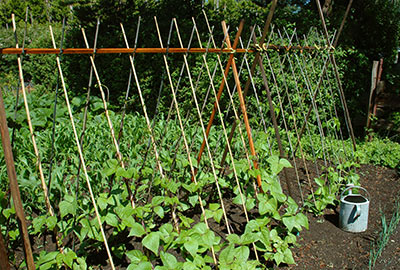Pole Beans: How Important is Companion Planting?

Plant pole beans with carrots, celery, chard, corn, cucumber, eggplant, peas, potatoes, radish, and strawberries. Avoid planting near chives, garlic, leeks, and onions. Pole beans and beets may stunt each other’s growth.
Some sources recommend planting beans or other legumes with plants that need a lot of nitrogen, but this advice may be misguided. Beans and other legumes that are grown to harvest use most or all of the nitrogen they fix in their roots. If roots, or better yet, entire legume plants, are left in soil or tilled under, or beans are tilled under when young before they produce pods and seeds, this may provide additional soil nitrogen to the crop that follows, but plants near actively growing beans and other legumes may obtain little to no nitrogen from the soil-fixing of legumes. If your legumes are fixing nitrogen (which you can determine by checking a few mature roots for nodules that appear pinkish or reddish on the outside or inside), consider rotating in a crop after the legumes that needs significant amounts of nitrogen, such as corn, tomatoes, potatoes, or squash.
The Three Sisters is a traditional Native American agricultural grouping that includes corn, beans, and squash, with corn providing a natural trellis for beans and vining squash, beans fixing soil nitrogen to the benefit of all three crops, and the large leaves of squash cooling soil and discouraging weeds. The Three Sisters can be tricky in some areas, and works best in areas without spring frosts and where summer temperatures are moderate, generally not higher than the mid-80s. Beans need cool-to-moderate temperatures with minimal to no frost, and suffer in heat; while corn needs warm nights and is tolerant of heat. Zucchini falls somewhere in between; it likes cool weather with days as low as 60° F but tolerates heat. Corn is started too late in many areas to provide ideal natural trellising for beans. While actively growing, beans and other nitrogen-fixing legumes may not provide extra nitrogen for heavy feeding by corn and zucchini; for extra nitrogen, beans should be tilled under before flowering.
To view customized instructions for growing pole bean, go to GardenZeus and enter your zip code, then go to pole bean. For a discussion of how the traditional Native American agricultural grouping of corn, beans, and squash may work in your area, see Three Sisters Companion Planting for California.